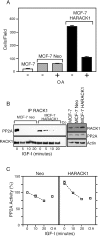Insulin-like growth factor I controls a mutually exclusive association of RACK1 with protein phosphatase 2A and beta1 integrin to promote cell migration
- PMID: 16705158
- PMCID: PMC1489096
- DOI: 10.1128/MCB.01868-05
Insulin-like growth factor I controls a mutually exclusive association of RACK1 with protein phosphatase 2A and beta1 integrin to promote cell migration
Abstract
The WD repeat scaffolding protein RACK1 can mediate integration of the insulin-like growth factor I receptor (IGF-IR) and integrin signaling in transformed cells. To address the mechanism of RACK1 function, we searched for regulatory proteins that associate with RACK1 in an IGF-I-dependent manner. The serine threonine phosphatase protein phosphatase 2A (PP2A) was found associated with RACK1 in serum-starved cells, and it dissociated immediately upon stimulation with IGF-I. This dissociation of PP2A from RACK1 and an IGF-I-mediated decrease in cellular PP2A activity did not occur in cells expressing either the serine 1248 or tyrosine 1250/1251 mutants of the IGF-IR that do not interact with RACK1. Recombinant RACK1 could bind to PP2A in vitro and restore phosphatase activity to PP2A from IGF-I-stimulated cells. Ligation of integrins with fibronectin or Matrigel was sufficient to facilitate IGF-I-mediated dissociation of PP2A from RACK1 and also to recruit beta1 integrin as PP2A dissociated. By using TAT-fused N-terminal and C-terminal deletion mutants of RACK1, we determined that both PP2A and beta1 integrin interact in the C terminus of RACK1 within WD repeats 4 to 7. This suggests that integrin ligation displaces PP2A from RACK1. MCF-7 cells overexpressing RACK1 exhibited enhanced motility, which could be reversed by the PP2A inhibitor okadaic acid. Small interfering RNA-mediated suppression of RACK1 also decreased the migratory capacity of DU145 cells. Taken together, our findings indicate that RACK1 enhances IGF-I-mediated cell migration through its ability to exclusively associate with either beta1 integrin or PP2A in a complex at the IGF-IR.
Figures










Similar articles
-
Tyrosine 302 in RACK1 is essential for insulin-like growth factor-I-mediated competitive binding of PP2A and beta1 integrin and for tumor cell proliferation and migration.J Biol Chem. 2008 Aug 22;283(34):22952-61. doi: 10.1074/jbc.M800802200. Epub 2008 Jun 19. J Biol Chem. 2008. PMID: 18567578
-
Effects of RACK1 on cell migration and IGF-I signalling in cardiomyoctes are not dependent on an association with the IGF-IR.Cell Signal. 2007 Dec;19(12):2588-95. doi: 10.1016/j.cellsig.2007.08.010. Epub 2007 Aug 29. Cell Signal. 2007. PMID: 17900863
-
Requirement of protein phosphatase 2A for recruitment of IQGAP1 to Rac-bound beta1 integrin.J Cell Physiol. 2005 Jun;203(3):487-92. doi: 10.1002/jcp.20249. J Cell Physiol. 2005. PMID: 15521075
-
Control of apoptosis in human multiple myeloma by insulin-like growth factor I (IGF-I).Adv Cancer Res. 2007;97:139-65. doi: 10.1016/S0065-230X(06)97006-7. Adv Cancer Res. 2007. PMID: 17419944 Review.
-
Regulation of IGF-I receptor signaling in tumor cells.Horm Metab Res. 2003 Nov-Dec;35(11-12):771-7. doi: 10.1055/s-2004-814166. Horm Metab Res. 2003. PMID: 14710357 Review.
Cited by
-
Targeting the IGF-1R: The Tale of the Tortoise and the Hare.Front Endocrinol (Lausanne). 2015 Apr 27;6:64. doi: 10.3389/fendo.2015.00064. eCollection 2015. Front Endocrinol (Lausanne). 2015. PMID: 25964779 Free PMC article. Review.
-
Extracellular matrix gene expression profiling using microfluidics for colorectal carcinoma stratification.Biomicrofluidics. 2016 Oct 31;10(5):054124. doi: 10.1063/1.4966245. eCollection 2016 Sep. Biomicrofluidics. 2016. PMID: 27822332 Free PMC article.
-
Combating resistance to anti-IGFR antibody by targeting the integrin β3-Src pathway.J Natl Cancer Inst. 2013 Oct 16;105(20):1558-70. doi: 10.1093/jnci/djt263. Epub 2013 Oct 3. J Natl Cancer Inst. 2013. PMID: 24092920 Free PMC article.
-
RACK1 regulates Src activity and modulates paxillin dynamics during cell migration.Exp Cell Res. 2007 Jul 15;313(12):2667-79. doi: 10.1016/j.yexcr.2007.05.013. Epub 2007 May 18. Exp Cell Res. 2007. PMID: 17574549 Free PMC article.
-
MACE-Seq-based coding RNA and TrueQuant-based small RNA profile in breast cancer: tumor-suppressive miRNA-1275 identified as a novel marker.BMC Cancer. 2021 Apr 29;21(1):473. doi: 10.1186/s12885-021-08218-4. BMC Cancer. 2021. PMID: 33910530 Free PMC article.
References
-
- Allan, G. J., D. J. Flint, and K. Patel. 2001. Insulin-like growth factor axis during embryonic development. Reproduction 122:31-39. - PubMed
-
- Beaulieu, J. M., T. D. Sotnikova, S. Marion, R. J. Lefkowitz, R. R. Gainetdinov, and M. G. Caron. 2005. An Akt/beta-arrestin 2/PP2A signaling complex mediates dopaminergic neurotransmission and behavior. Cell 122:261-273. - PubMed
-
- Berns, H., R. Humar, B. Hengerer, F. N. Kiefer, and E. J. Battegay. 2000. RACK1 is up-regulated in angiogenesis and human carcinomas. FASEB J. 14:2549-2558. - PubMed
-
- Boudreau, R. T., R. Garduno, and T. J. Lin. 2002. Protein phosphatase 2A and protein kinase Calpha are physically associated and are involved in Pseudomonas aeruginosa-induced interleukin 6 production by mast cells. J. Biol. Chem. 277:5322-5329. - PubMed
-
- Buensuceso, C. S., D. Woodside, J. L. Huff, G. E. Plopper, and T. E. O'Toole. 2001. The WD protein Rack1 mediates protein kinase C and integrin-dependent cell migration. J. Cell Sci. 114:1691-1698. - PubMed
Publication types
MeSH terms
Substances
LinkOut - more resources
Full Text Sources
